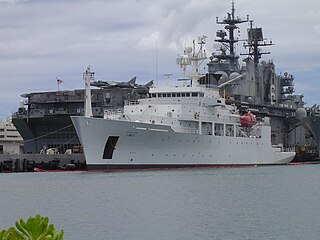Sumner has been the name of four ships in the United States Navy. The destroyers, DD-333 and DD-692, were named after World War I Marine Corps Captain Allen Melancthon Sumner. The survey ships, AGS-5 and T-AGS-61, were named after the 19th century Navy captain Thomas Hubbard Sumner.
USS or USNS Maury may refer to the following ships, named for Commodore Matthew Fontaine Maury:
USS Sacagawea may refer to the following ships of the United States Navy:
Two ships of the United States Navy have borne the name Dutton in honor of Captain Benjamin Dutton, Jr.

USNS Sumner (T-AGS-61) is a Pathfinder-class oceanographic survey ship that became operational in 1997. It is the fourth United States Navy ship named Sumner. These ships are crewed by a small crew of civilian mariners, supporting an even smaller contingent of United States Navy personnel.
Lake Washington Shipyards was a shipyard in the northwest United States, located in Houghton, Washington on the shore of Lake Washington, east of Seattle. Today, the shipyards are the site of the lakeside Carillon Point business park. The shipyards built many civilian and U.S. Navy ships.

The Pathfinder-class survey ships are owned by the United States Navy and operated by Military Sealift Command for the Naval Oceanographic Office ("NAVOCEANO"). They have mostly civilian crews, including scientists from NAVOCEANO.

USNS Henson (T-AGS-63) is a Pathfinder-class oceanographic survey ship. It is the fourth ship in the class. Henson is named after Matthew Henson, who accompanied Robert Peary, most famously on an expedition intended to reach the Geographic North Pole in 1909.
USNS Bowditch (T-AGS-21) was the lead ship of her class of oceanographic survey ships for the United States Navy. Launched as the SS South Bend Victory in 1945, Maritime Commission hull number MCV 694, a type VC2-S-AP3 Victory ship, she was named for Nathaniel Bowditch, the second U.S. Navy vessel named in his honor. The ship was acquired by the Navy in August 1957 and converted to an AGS at Charleston Naval Shipyard. Named Bowditch on 8 August 1957 and placed in service 8 October 1958 for operation by the Military Sea Transportation Service (MSTS).

USS Pathfinder (AGS-1) was a survey vessel for the United States Navy during World War II. Before and after the war she was USC&GSS Pathfinder (OSS-30) for the United States Coast and Geodetic Survey, named after the USC&GSS Pathfinder (1899-1941) that had surveyed and was lost in the Philippines at Corregidor. Pathfinder ended her service 23 December 1971 as she and the Coast and Geodetic Survey itself had come the National Ocean Survey under the National Oceanic and Atmospheric Administration (NOAA).
USS Harkness may refer to:
USS Bowditch or USNS Bowditch may refer to:

USS Oceanographer (AGS-3) was a survey ship of the United States Navy during World War II that produced charts chiefly of passages in the Solomon Islands area of the Pacific Ocean. Upon transfer to the Navy, she had initially briefly been named and classed as gunboat USS Natchez (PG-85). Before her World War II Navy service, she had been USC&GS Oceanographer (OSS-26), a survey ship with the U.S. Coast and Geodetic Survey from 1930.
USC&GS Oceanographer was the name of two ships of the United States Coast and Geodetic Survey, and may refer to:
USC&GS Hydrographer was the name of two United States Coast and Geodetic Survey ships, and may refer to:
USNS Bowditch has been the name of more than one United States Navy ship, and may refer to:

USNS Maury (T-AGS-66) is a Pathfinder-class oceanographic survey ship. It is the seventh ship in the class. Maury is named after Commander Matthew Fontaine Maury, the "Father of Modern Oceanography" who infamously resigned from the United States Navy to sail for the Confederacy. Maury is the first oceanographic survey ship built since USNS Mary Sears, was launched in 2000. At approximately 350 feet (110 m), Maury is 24 feet (7.3 m) longer than its other sister ships in the same class. This modification is to accommodate a 300-square-foot (28 m2) moon pool for unmanned vehicle deployment and retrieval.

USNS John McDonnell (T-AGS-51) was a hydrographic survey ship operated by the Military Sealift Command (MSC) with a contract crew for the Naval Oceanographic Office which assigned a military and civilian hydrographic detachment to conduct coastal surveys. The ship and its sister, USNS Littlehales (T-AGS-52), were replacements for the coastal hydrographic survey vessels USNS Chauvenet (T-AGS-29) and USNS Harkness (T-AGS-32).
USS John Blish was a Patrol Craft Sweeper (PCS) of the PCS-1376-Class, five of which were converted to small hydrographic survey vessels designated AGS and later coastal survey vessels, AGSc, that conducted hydrographic surveys for the United States Navy during and immediately after the Second World War. The small PCS type vessels assigned to the United States Navy Hydrographic Office missions conducted pre invasion surveys, sometimes under fire, with the survey crews erecting signals for survey and later navigation, laying buoys and placing lights.
This page is based on this
Wikipedia article Text is available under the
CC BY-SA 4.0 license; additional terms may apply.
Images, videos and audio are available under their respective licenses.






